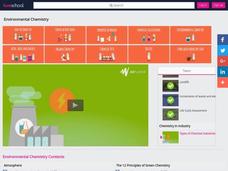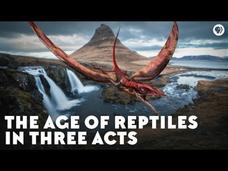Crash Course
Controlling the Environment: Crash Course History of Science #39
What would the world look like if we could control the weather? Historically, countries have attempted to do just that, but their intentions were not always good! The 39th lesson in a History of Science series describes science projects...
NASA
Introduction to Real Air Traffic Control—Problem Set A
Understand what it takes to control planes safely. The first lesson in a series of six introduces the class to the air traffic control situation. The pupils develop their understanding of units used in air travel, then learn how to read...
Curated OER
Cameron Diaz Talks Trees
What is so wonderful about trees? Professor Grover and Cameron Diaz explain all of the amazing things trees can do. Viewers will learn that trees clean the air, give us shade, provide us with food, and are home to many animals.
Fuse School
How The Atmosphere Changed
Has Earth's atmosphere always been capable of supporting life? Discover how the air around us has evolved in the first video in a series of seven. Learners watch the amazing transformations that occurred within the atmosphere...
Fuse School
Types of Chemical Industries
Four percent of the world's CO2 emissions come from the chemical industry. The video discusses the environmental impact of industry. From using non-renewable resources, requiring high levels of energy, to polluting the ground, water, and...
Be Smart
The Largest River on Earth Is in the Sky
Water vapor released by trees in the Amazon creates a floating river. In fact, it's the largest river on Earth! A video presentation examines the science behind the water vapor and explains how rains seeds form to create clouds.
PBS
The Age of Reptiles in Three Acts
Reptiles survived the largest extinction event on the planet and then they grew into the most dominant class of the Mesozoic Era. They quickly evolved into giants on land, sea, and air. In an episode of the PBS Eons series viewers learn...
Crash Course
Nitrogen and Phosphorus Cycles: Always Recycle! Part 2
We wish you a happy, healthy, and phosphorus school year! A video explains the importance of getting the nutrients that are needed and focuses on the nitrogen and phosphorus cycles. It includes discussions on the importance of...
TED-Ed
Why the Arctic Is Climate Change's Canary in the Coal Mine
What happens in the Arctic doesn't always stay in the Arctic. Follow along with this short video as it investigates how small changes in the temperature of Arctic regions can have dramatic effects on the global climate through a series...
MinuteEarth
How Do Trees Survive Winter?
Explore trees' strategies for surviving winters in cold climates. The first trees were built for tropical climates. As they migrated to colder climates, they adapted the capability to survive the harsher weather. The video lesson...
PBS
That Time Oxygen Almost Killed Everything
Oxygen keeps us alive, but did you ever consider how Earth found the right balance? Eons produced this video as part of a larger series that explores when Earth contained very little oxygen and green oceans ruled the planet. Viewers see...
Veritasium
An Astronaut's View of Earth
Ever wonder what climate change looks like from above? See Earth's struggle through the eyes of Commander Chris Hadfield with a video from the Veritasium playlist. Commander Hadfield describes his amazing journey through the Southern...
Crash Course
Natural Selection
The peppered moth is featured in a video about natural selection. The narrator tells the story of Darwin's theory and then moves on to the principles behind natural selection and the different ways it works. Concepts covered include...
American Chemical Society
Why Is the Statue of Liberty Green?
See how Lady Liberty turned green. Young scientists learn that oxidation reactions have caused the originally red-brown Statue of Liberty to become its current shade of green. An engaging video explains how the copper in the statue...
MinuteEarth
Denizens of the Deep
Dive into a lesson on the habitat of Earth least studied. A creative lesson describes the characteristics of animals that live in the deepest depths of the ocean. It also shares the concern of scientists that fishing these depths may...
SciShow
NASA Might Send a Helicopter to Mars
It turns out driving a remote rover from more than 50 million kilometers away is a difficult task. But, what if a drone could scout the terrain in advance? That is the premise of the proposed Mars 2020 rover. A SciShow Space series video...
PBS
Pbs Kids: Sci Girls: Earth & Beyond
SciGirls videos feature real girls putting science and engineering to work to answer real-life questions and make discoveries in the world around them. This collection explores oceans, sky, and earth environments.
PBS
Pbs Learning Media: Capturing Carbon
In this video segment adapted from NOVA scienceNOW, a scientist, inspired by his daughter's science fair project, develops a synthetic tree to remove excess carbon dioxide from the air. [5:23]

















